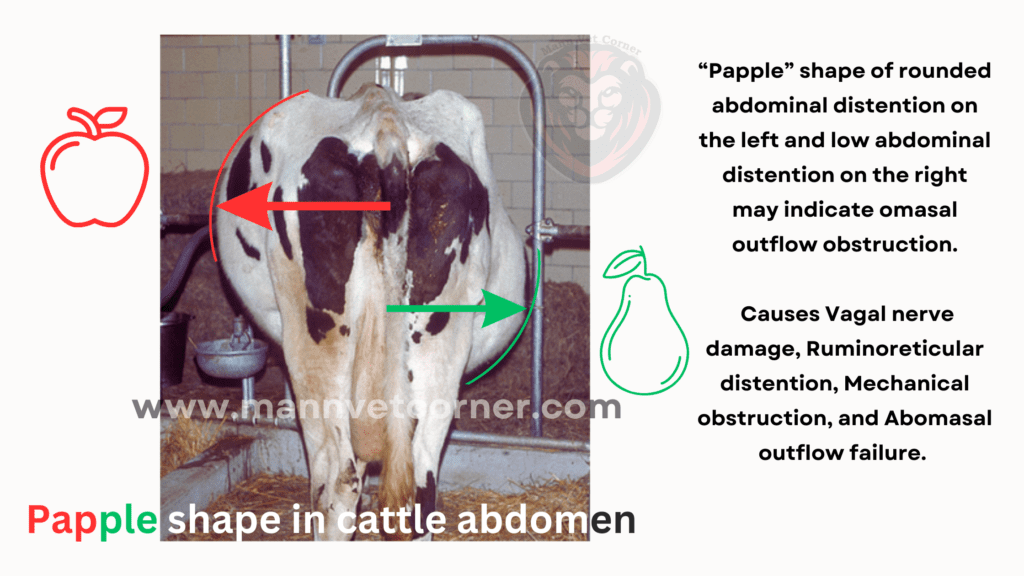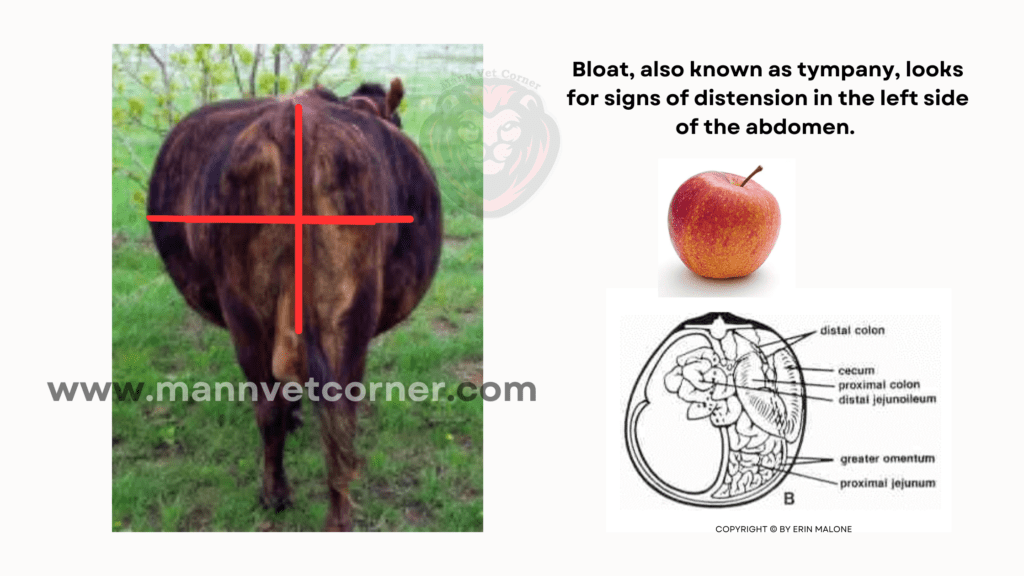The abdominal contour of a cow serves as a crucial diagnostic indicator in veterinary practice. By carefully assessing the shape of a cow’s abdomen, I can determine potential health issues related to digestion, fermentation, and gas accumulation. The three primary abdominal shapes—pear-shaped, apple-shaped, and papple-shaped—each signify different underlying conditions. In this article, I will explore these contours in detail and compare them to bloat (tympany), a serious digestive disorder that can affect cattle health and productivity.
Understanding the Three Abdominal Shapes in Cows
1. Pear-Shaped Abdomen (Normal Condition)

A healthy cow typically exhibits a pear-shaped abdomen when viewed from behind. This shape is characterized by:
- A slight distension in the lower abdomen, caused by normal rumen fill and digestive processes.
- A symmetrical appearance, with both left and right sides of the abdomen appearing even.
- No excessive bulging, bloating, or asymmetry.
This shape is a sign of a normal, healthy digestive process, indicating proper feed intake, rumination, and digestion.
2. Apple-Shaped Abdomen (Bilateral Distension)

A cow with an apple-shaped abdomen appears symmetrically distended on both sides, resembling a round or inflated form. This condition is commonly associated with free gas bloat, which occurs when gas cannot escape from the rumen due to an obstruction or impaired eructation (belching). Key characteristics include:
- A distended, rounded belly on both the left and right sides.
- Difficulty breathing and discomfort due to pressure on the diaphragm.
- A dull or drum-like sound when tapping the abdomen (tympanic resonance).
- A risk of sudden death if left untreated.
3. Papple-Shaped Abdomen (Asymmetrical Distension)

The papple-shaped abdomen is a combination of the pear and apple shapes. It occurs when the left side is markedly distended, while the right side remains normal or slightly sunken. This abnormal shape often points to vagal indigestion, a condition that results in:
- Poor motility of the rumen and reticulum.
- Accumulation of ingesta and gas on the left side.
- A gradual but persistent enlargement of the left abdomen.
- Reduced feed intake and weight loss.
Comparing These Abdominal Contours with Bloat (Tympany)
Bloat, also known as ruminal tympany, is a severe digestive disorder characterized by the abnormal accumulation of gas in the rumen. This condition can be life-threatening if not managed promptly. Let’s compare bloat with the three abdominal shapes described above:
| Condition | Description | Causes | Signs & Symptoms |
|---|---|---|---|
| Pear-Shaped Abdomen | Normal digestive process | Balanced feed intake, proper rumination | No discomfort, even rumen fill |
| Apple-Shaped Abdomen | Symmetrical bloating (gas accumulation) | Free gas bloat (obstructed esophagus, lack of eructation) | Distended both sides, difficulty breathing, tympanic sound |
| Papple-Shaped Abdomen | Asymmetrical bloating (left-sided enlargement) | Vagal indigestion (reticulo-rumen dysfunction) | Left-sided distension, sluggish digestion, weight loss |
Bloat / Tympany: A Critical Comparison
- Free Gas Bloat: This condition leads to an apple-shaped abdomen with excessive gas accumulation in the rumen due to blockage or nerve dysfunction.
- Frothy Bloat: This occurs due to foam formation in the rumen, preventing gas from escaping. The abdomen may appear distended but not as rigid as in free gas bloat.
- Vagal Indigestion: Unlike bloat, vagal indigestion (papple-shaped abdomen) results from a motility issue rather than gas trapping.

Causes of Abdominal Distension and Bloat in Cattle
Understanding the causes of abnormal abdominal contours can help prevent digestive complications in cattle. Common causes include:
1. Dietary Factors
- Rapid consumption of highly fermentable carbohydrates (e.g., grain overload).
- Ingestion of leguminous plants (e.g., alfalfa, clover), leading to frothy bloat.
- Poor-quality or moldy feed, which disrupts rumen microflora.
2. Physical Blockages
- Foreign body obstruction (e.g., plastic, rope, twine) leading to esophageal blockages.
- Enlarged lymph nodes or tumors compressing the esophagus.
3. Rumen Motility Issues
- Vagal indigestion due to nerve damage or chronic hardware disease.
- Peritonitis or adhesions restricting normal rumen contractions.
4. Infectious and Metabolic Disorders
- Clostridial infections, causing gas-producing fermentation.
- Hypocalcemia (milk fever), reducing smooth muscle function and ruminal motility.
Diagnosis and Treatment of Bloat and Abdominal Distension
1. Clinical Examination
Veterinarians diagnose abdominal distension through:
- Visual assessment of abdominal shape (pear, apple, papple).
- Auscultation and percussion to detect tympanic resonance.
- Rectal examination to assess rumen fill and motility.
2. Treatment Approaches
- Free Gas Bloat: Immediate relief using a stomach tube to release trapped gas.
- Frothy Bloat: Administering antifoaming agents like mineral oil or poloxalene.
- Vagal Indigestion: Managing underlying causes (e.g., removing foreign bodies, treating infections).
- Surgical Intervention: In severe cases, a rumenotomy may be necessary.
3. Preventive Measures
- Diet Management: Avoid excessive legume feeding and introduce grains gradually.
- Regular Deworming: Prevent parasitic infections affecting rumen health.
- Foreign Object Prevention: Remove plastic waste from grazing areas.
Conclusion
Understanding the abdominal contour of a cow is essential for identifying and managing digestive disorders such as bloat and vagal indigestion. By recognizing the differences between pear-shaped, apple-shaped, and papple-shaped abdomens, farmers and veterinarians can take proactive steps to maintain cattle health and prevent serious complications. Early intervention, proper dietary management, and timely veterinary care are key to ensuring optimal digestive function in cattle.
